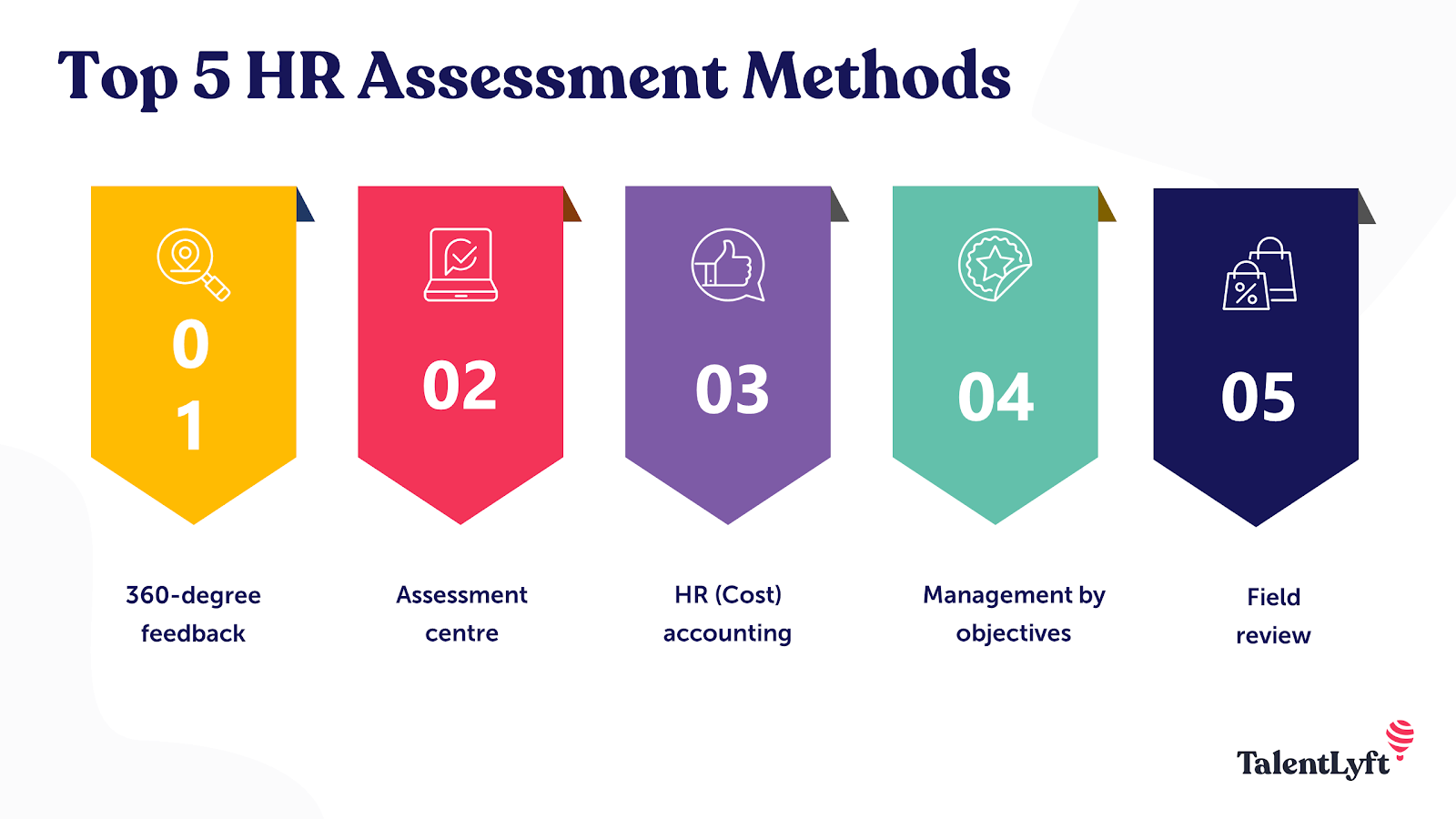
What is the best way to assess how well HR is working in a company? Discover the 5 most used HR assessments methods in 2020, as well as their pros and cons.
What is the best way to assess how well HR is working in a company? Discover the 5 most used HR assessments methods in 2020, as well as their pros and cons.
For a business to grow, it needs to analyze what is working well in the company, and which areas require improvement. Though assessments should be a company-wide initiative, there is one area that requires more focus - human resources.
HR has a great deal of responsibility in a company, which is why this team needs thoughtful assessment protocols. We will look at five different ways to assess how well HR is working in a company in this article.
Here are 5 most commonly used HR assessment methods in 2020:

In the HR assessment realm, one of the most popular methods is the 360-Degree Feedback review. This method requires the HR manager and assessor to collect feedback on an employee’s performance from everyone affiliated with them.
The employee’s peers, reports, direct managers, and managers from other departments that the employee conferred with on a project, are all asked for their feedback on the employee’s performance, their work ethic, their deliverables, general competence, and their behavior.
The 360-degree feedback method ensures that the assessment system takes into account multiple points of view for a holistic report from in-house and remote working staff. And it is an important way to understand how an employee works within a company.
People have different equations with each other - if you ask only one or two people for their thoughts on a person’s competence, you could get a biased viewpoint. By speaking to everyone involved with a single individual, one is able to reach a more thorough appraisal of the employee.
You can get insights into how they handle goals, stress, project management, and whether the person deserves to be moved into a leadership position.
✅❌ Pros and cons of this assessment method
The 360-degree feedback method gives the assessor a wholesome view of an employee’s abilities, not only in the professional arena but also as a yardstick for understanding interpersonal interactions.
However, it can take a great deal of time and money to conduct the method, particularly if the company has a very large staff. The feedback one receives for each team will also have to be personalized to some level - the amount of physical labor produced in one department may not be comparable to another.
One also needs to prioritize the areas of focus in the assessment - is it more important for employees to strive to achieve company goals or to create a collaborative environment? Weighing the analytics achieved from this method can take some trial and error but one can reach a standardized system with careful planning.
The Assessment Centre Method takes HR assessment outside the confines of the office, often to a central location where managers, assessors, and employees can gather. In the Assessment Centre Method, individuals are asked to perform a series of tasks or are grouped together to perform tasks.
Interestingly, this method was first created in the 1930s by the German army and has since been adapted for modern employment. In this method, assessors can examine very particular work-related skills that employees and applicants will need in a company by giving them exercises, conducting workshops, role-playing games, and simulations.
The HR team can use a mind map to assess the following skills included in this method:
While this method can give HR managers a wealth of knowledge about the social and interaction skills of individuals, it does not give you any specific role-related data.
Additionally, because of the competitive nature of the exercises, one may end up breeding an overly competitive environment that will overlap into company culture after the tests are complete.
As a system for checking on interpersonal skills, the Assessment Centre Method has its benefits, but it should be paired with another assessment for more comprehensive results.
✅❌ Pros and cons of this assessment method
The Assessment Centre Method has its advantages - by taking employees out of the confinement of the workplace, one can see how they organically react to situations.
However, as noted above, the competitive nature of this method can bring to the fore unhealthy behaviors - while that may be telling in and of itself, the employees then need to return to the workplace where the actions performed during this assessment may lead to resentment.
This method should be carefully monitored and administered only alongside another method for the best results.
Employees are a resource for businesses, just as capital and machinery are. In that sense, there needs to be an account of how much cost is going into maintaining human resources, and what kind of labor output is being gained in return.
The Human-Resource (Cost) Accounting Method asks HR managers to look at how much is being spent on individual employees’ training, compensation, and development. What are the costs spent on recruitment drives, resource planning, training, and orientation?
HR managers then have to balance those costs against the productivity of the employees and whether the training and development programs have resulted in higher yield for the company.
Not everything can be decided according to a money-in-productivity out system, however- some employees bring more value to the company than just their labor. For example, a few employees may boost morale, others may have invaluable external contacts, and another group may show their teams how to work smart.
This is a very cold and calculated way of looking at human capital, and should not be the sole assessment criteria used to determine the future of employees in companies.
✅❌ Pros and cons of this assessment method
There is value to using the Human-Resource (Cost) Accounting Method - it does show you the kinds of gains and losses your human capital is bringing in.
However, this is another method that takes time and energy - one needs to collate costs from across the company and compare it to what is being earned or lost per employee. A single error could mean the end of someone’s employment so this is not a foolproof method to rely on.
Management by Objectives (MBO) was coined by Peter Drucker, author of several management books and well-known guru, and is one of the most popular assessment types used by HR managers. In this method, employees and managers sit together at the start of every year, or quarter, and outline goals and the processes needed to reach those goals for the next financial period.
This assessment type is ideal for a collaborative environment and makes the interpersonal relationships between managers and subordinates much stronger. Setting achievable goals will motivate employees and make their work more easily measurable - such as a 10% increase in social media followers, or 15% more unique website views - and help to create more manageable monthly reports.
However, it is important to ensure that there are enough goals for an employee to be engaged and motivated, but not too many, as that will put undue pressure on the employee. This method yields strong results but fails to take in interpersonal and communication skills, so it should be paired with another method like the 360-Degree Feedback assessment.
✅❌ Pros and cons of this assessment method
Almost all companies use the Management by Objectives (MBO) assessment method - the results are measurable and it gives employees dedicated targets to strive towards. It takes up the least amount of time for managers and HR teams and has had great results over the years.
The MBO method has its advantages but it has been used by managers to give employees unreasonably high goals - almost punishing them for high achievements in the past. This should be noted and avoided as much as possible - employees shouldn’t feel afraid of achievement because they will be overburdened, as a result, in the following year.
One of the more traditional assessment types is the Field Review Method. In this method, a person from the HR department shadows and assesses an employee to evaluate their working styles, effectiveness, and output.
This method can be labor-intensive, especially for HR as they will need to take a significant amount of time out of their schedules to study the employee. Additionally, the HR team may not have a thorough understanding of another department’s methods or their work - this will make assessment tricky.
However, if the HR team is concerned that employees would otherwise not be getting an unbiased review from their managers or peers, the Field Review Method can be effective. This method needs to be seriously considered before implementation so that the results are as accurate as necessary.
✅❌ Pros and cons of this assessment method
The Field Review Assessment method is rarely used in the modern workplace setting- with larger corporations becoming the norm, it isn’t possible for HR teams to perform this process.
However, this system could have merits in smaller, controlled environments - as long as it is paired with a more thorough and efficient, as outlined above.
Running a company requires a great deal of ongoing assessment of all the company’s resources. But when it comes to human resources, the techniques used to assess people need more nuance and understanding.
The above methods are the most commonly used in HR but not all of them may be the right fit for your team and company. Because, as outlined above, no one assessment method gives you a complete overview of an employee’s role and achievements.
By trying out a few, you can find the combination that works best for your company and ensures your employees are fulfilled and productive.
Ronita Mohan is a content marketer at Venngage, the online infographic template and design platform. Ronita regularly writes about the HR process, workplace productivity, design, digital marketing, pop culture, and the need for diversity.
What are the Most Commonly Used HR Assessment Methods?
The most commonly used HR assessment methods in 2020 include 360-degree feedback, assessment center, HR (cost) accounting, Management by Objectives (MBO), and field review. Each method has unique advantages and is suited for different aspects of assessing employee performance and contribution.
How Does the 360-Degree Feedback Method Work in HR Assessment?
The 360-degree feedback method involves collecting feedback on an employee’s performance from a wide range of sources, including peers, managers, direct reports, and other departments. This method provides a comprehensive view of the employee’s performance, work ethic, and behavior within the company.
What is the Assessment Center Method in HR?
The Assessment Center Method involves taking HR assessments outside the office to a central location. Here, employees are asked to perform tasks or grouped together for activities. This method primarily assesses work-related skills through exercises, workshops, role-playing games, and simulations.
What is Management by Objectives (MBO) in HR Assessment?
Management by Objectives (MBO) is an HR assessment method where employees and managers set specific, measurable goals for a certain period. This method strengthens manager-employee relationships, makes the work more measurable, and helps in creating manageable reports, but it focuses less on interpersonal skills.
How is the Field Review Method Conducted in HR Assessment?
The Field Review Method involves a member of the HR team shadowing and evaluating an employee. This method can be labor-intensive and requires a thorough understanding of various departmental functions. It's effective when unbiased reviews are necessary but is less commonly used in larger organizations.












